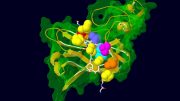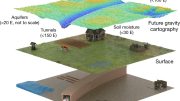
DeepMind shows that neural networks can more accurately describe electron interactions in chemical systems compared to existing methods.
- In a paper published by Science, DeepMind demonstrates how neural networks can improve approximation of the Density Functional (a method used to describe electron interactions in chemical systems).
- This illustrates deep learning’s promise in accurately simulating matter at the quantum mechanical level.
- Alongside the paper, DeepMind will open-source the code to provide a research foundation for others to build on.
In a paper published in the scientific journal Science, DeepMind demonstrates how neural networks can be used to describe electron interactions in chemical systems more accurately than existing methods.
Density Functional Theory, established in the 1960s, describes the mapping between electron density and interaction energy. For more than 50 years, the exact nature of mapping between electron density and interaction energy — the so-called density functional — has remained unknown. In a significant advancement for the field, DeepMind has shown that neural networks can be used to build a more accurate map of the density and interaction between electrons than was previously attainable.
By expressing the functional as a neural network and incorporating exact properties into the training data, DeepMind was able to train the model to learn functionals free from two important systematic errors — the delocalization error and spin symmetry breaking — resulting in a better description of a broad class of chemical reactions.
In the short term, this will empower researchers with an improved approximation of the exact Density Functional for immediate use through the availability of our code. In the long term, it is another step showing deep learning’s promise in accurately simulating matter at the quantum mechanical level — which may enable material design in a computer by allowing researchers to explore questions about materials, medicines, and catalysts at the nanoscale level.
“Understanding technology at the nanoscale is becoming increasingly crucial in helping us tackle some of the major challenges of the 21st century, from clean electricity to plastic pollution,” says James Kirkpatrick, Research Scientist at DeepMind. “This research is a step in the right direction towards enabling us to better understand the interactions between electrons, the glue that holds molecules together.”
With the aim of accelerating progress in the field, DeepMind has made the paper, and open-sourced code freely available.
Reference: “Pushing the frontiers of density functionals by solving the fractional electron problem” by James Kirkpatrick, Brendan McMorrow, David H. P. Turban, Alexander L. Gaunt, James S. Spencer, Alexander G. D. G. Matthews, Annette Obika, Louis Thiry, Meire Fortunato, David Pfau, Lara Román Castellanos, Stig Petersen, Alexander W. R. Nelson, Pushmeet Kohli, Paula Mori-Sánchez, Demis Hassabis and Aron J. Cohen, 9 December 2021, Science.
DOI: 10.1126/science.abj6511
About DeepMind
DeepMind is a scientific discovery company committed to ‘solving intelligence to advance science and humanity.’ Solving intelligence requires a diverse and interdisciplinary team working closely together – from scientists and designers, to engineers and ethicists – to pioneer the development of advanced artificial intelligence.
The company’s breakthroughs include AlphaGo, AlphaFold, over one thousand published research papers (including more than a dozen in Nature or Science), partnerships with scientific organizations, and hundreds of contributions to Google’s products (in everything from Android battery efficiency to Assistant text-to-speech).









… lets pray for some deviations!!! Om, or how so scientist pray…